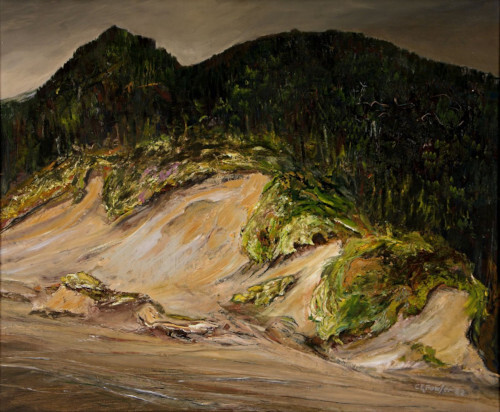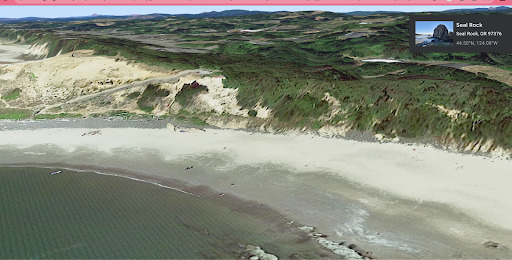Beach Cliff
Never displayed in public prior to its donation to the Hallie Ford Museum of Art, Beach Cliff was a gift from the Fowler family, where it has been displayed in their home.
Beach Cliff is a wonderful example of Fowler’s skill in painting and the creation of drama. The painting is filled with shadows and light, and a grey sky that sits atop the painting, seemingly creating some of the intense shadows on the cliffs in the background of the painting. These cliffs are covered in dark vegetation, possibly trees, because of the vertical brushstrokes. In the foreground, however, is the main cliff that dominates over half the composition of the painting. It rises towards the left of the canvas and slopes down slightly at a diagonal going to the right of the canvas. This cliff is covered in vegetation that seems almost to melt off and blend into the sand due to the many colors swirled inside the green such as browns, purples, and yellow. The brown that undercuts the green patches on the cliff allows it to stand out against the tan face of the cliff. The sand in the foreground is tan with some brown and white that seems to rush forward, perhaps caused by the tide coming in far. Up close, the paint jumbles together, but from afar, the painting becomes the beautiful natural scene it is- forcing the viewer to interact physically with the painting and pay close attention to it.
Though there is not a specific geographic name for the cliffs, it is likely from the Oregon coast or Pacific Northwest coast in general and does resemble cliffs on the Oregon coast, such as in Seal Rock-
Overall it's a compelling painting that depicts a part of nature often overlooked in favor of the ocean, the hills surrounding the beaches, and it forces us to appreciate the beauty and drama of nature. The cliffs are intimidating but captivating as they present themselves to the viewer as a dark swirling mass. Beach Cliff thus also takes from the tradition of the Sublime but painted in her own way just as she explored different forms of representation that appealed to her artistic curiosity throughout her life.


